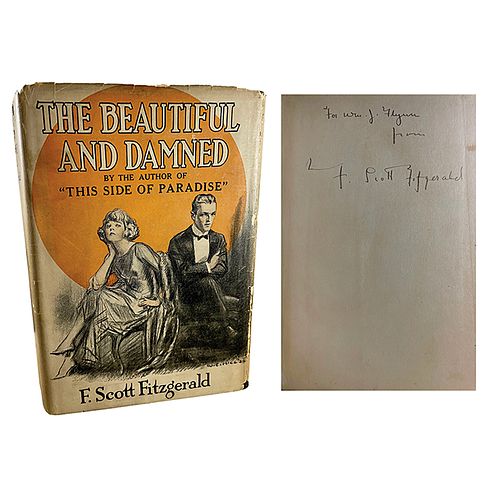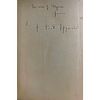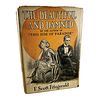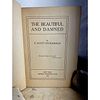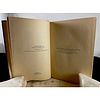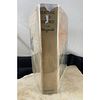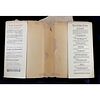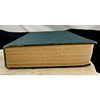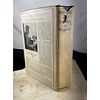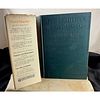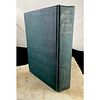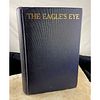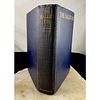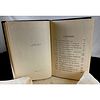F. Scott Fitzgerald Signed First Edition of The Beautiful and Damned
Two ways to bid:
- Leave a max absentee bid and the platform will bid on your behalf up to your maximum bid during the live auction.
- Bid live during the auction and your bids will be submitted real-time to the auctioneer.
Bid Increments
| Price | Bid Increment |
|---|---|
| $0 | $5 |
| $50 | $10 |
| $200 | $25 |
| $500 | $50 |
About Auction
Oct 12, 2022
RR Auction support@rrauction.com
- Lot Description
Signed book: The Beautiful and Damned. First edition, first printing (Scribners colophon NOT present on copyright page), Bruccoli A 8.I.a. NY: Charles Scribner's Sons, 1922. Hardcover bound in green cloth, lettered in gilt and blind, with first printing pictorial dust jacket (title in white lettering), 5.5 x 7.75, 449 pages. Signed and inscribed on a free end page in fountain pen to William J. Flynn, Chief of the United States Secret Service, “For Wm. J. Flynn, F. Scott Fitzgerald.” The signature and inscription match the handwriting of Fitzgerald's early 1920-1922 success; unique, yet generally less floral than his handwriting in 1923-1924. Autographic condition: fine, with a small stain and vertical fold to the right of the signature. Book condition: VG/VG, with light wear to spine and boards, a bump to lower back corner, and very light toning to endpapers; some sunning, chipping, and paper loss to jacket, which bears a few short tape repairs (neutral pH, acid-free, removable museum conservation tape) to the inside. Accompanied by a first edition of Flynn’s 1919 spy novel The Eagle’s Eye.
Fitzgerald's second novel, The Beautiful and Damned is a classic Jazz Age tale of elite American society, generally considered to be based on his own relationship with his wife Zelda. Following his best-selling debut novel This Side of Paradise, Scribner's prepared an initial print run of 20,000 copies, and mounted a publicity campaign. It sold well enough to put 50,000 copies into print with later runs. As a highly desirable first edition of the work boasting a large signature, complete with its uncommon in first printing dust jacket, this is an extraordinary piece.
After years of investigating the American mafia and reorganizing the New York City detective department, plumber-turned-secret agent William J. Flynn (1867-1928) was named as Chief of the Secret Service and served in said position from 1912 to 1917. As Chief, Flynn uncovered and dismantled a German spy ring that saved countless American lives, actions that rewarded him with the Directorship of the Bureau of Investigation. After World War I, Flynn's obsessive dedication to destroying German espionage soon became viewed as counterproductive by the U.S. Government. Retired from active service and left with little more than commendations, Flynn then turned to another of his interests—writing crime fiction.
He placed articles in journals and newspapers like the Washington Post and New York Herald, and his growing reputation soon had him meeting many of New York's noted novelists. In 1916-17, Flynn collaborated with Courtney Ryley Cooper—future author of such well-known books as Under the Big Top and Oklahoma—to write The Eagle's Eye, published by Prospect Press of New York. Flynn went on to write storylines for New York movie producers while also editing and publishing his Weekly Detective Fiction magazine, which became highly successful.
Exactly when and where Flynn met Fitzgerald is speculative, but it was evidently not long after The Beautiful and the Damned was published in March 1922, as F. Scott and Zelda Fitzgerald were still celebrating in Manhattan through the spring of that year. Certainly, the meeting would be of grand interest, especially since Flynn appears to have been a pragmatist and definitely quite different from Fitzgerald, the romantic egoist. - Shipping Info
-
Bidder is liable for shipping and handling and providing accurate information as to shipping or delivery locations and arranging for such. RR Auction is unable to combine purchases from other auctions or affiliates into one package for shipping purposes. Lots won will be shipped in a commercially reasonable time after payment in good funds for the merchandise and the shipping fees are received or credit extended, except when third-party shipment occurs. Bidder agrees that service and handling charges related to shipping items which are not pre-paid may be charged to a credit card on file with RR Auction. Successful international Bidders shall provide written shipping instructions, including specified Customs declarations, to RR Auction for any lots to be delivered outside of the United States. NOTE: Declaration value shall be the item’(s) hammer price and RR Auction shall use the correct harmonized code for the lot. Domestic Bidders on lots designated for third-party shipment must designate the common carrier, accept risk of loss, and prepay shipping costs.
-
- Buyer's Premium



 EUR
EUR CAD
CAD AUD
AUD GBP
GBP MXN
MXN HKD
HKD CNY
CNY MYR
MYR SEK
SEK SGD
SGD CHF
CHF THB
THB